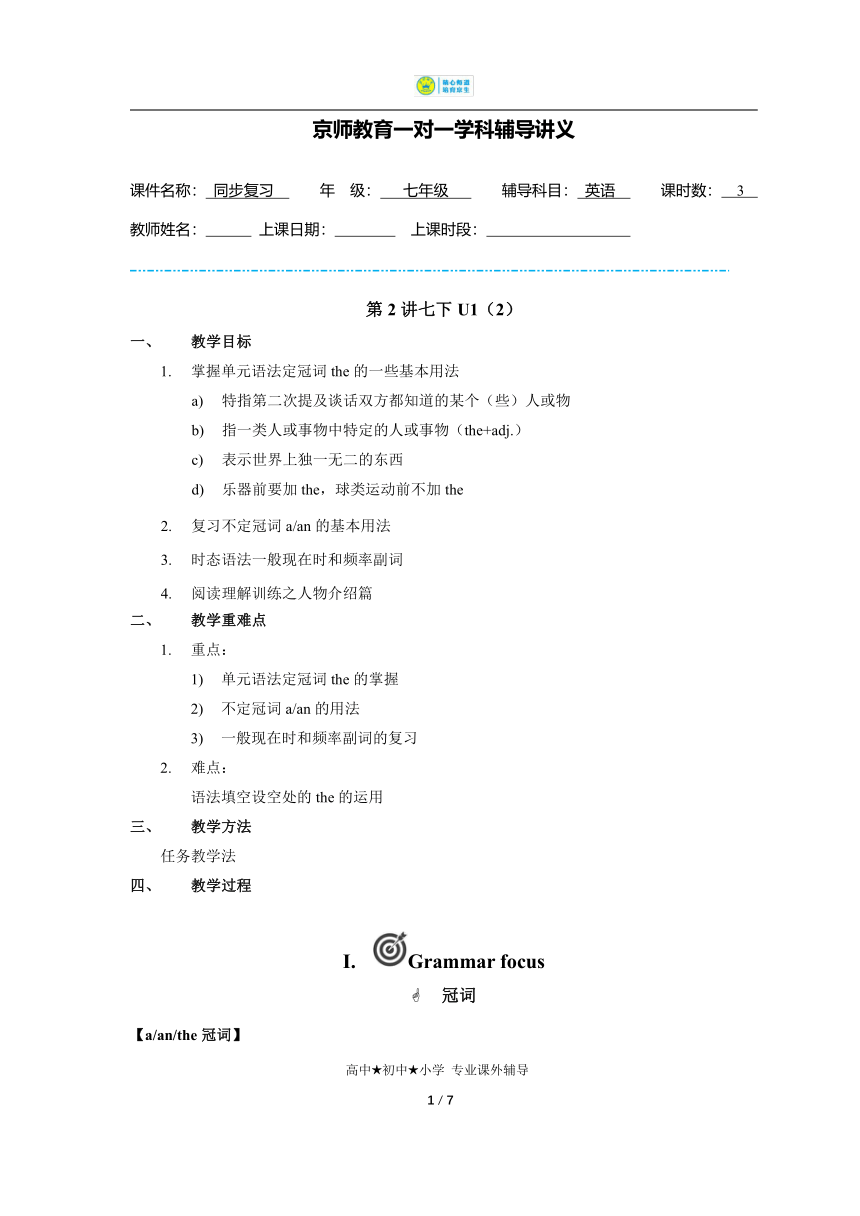
京师教育一对一学科辅导讲义 课件名称: 同步复习 年 级: 七年级 辅导科目: 英语 课时数: 3 教师姓名: 上课日期: 上课时段: 第2讲七下U1(2) 教学目标 掌握单元语法定冠词the的一些基本用法 特指第二次提及谈话双方都知道的某个(些)人或物 指一类人或事物中特定的人或事物(the+adj.) 表示世界上独一无二的东西 乐器前要加the,球类运动前不加the 复习不定冠词a/an的基本用法 时态语法一般现在时和频率副词 阅读理解训练之人物介绍篇 教学重难点 重点: 单元语法定冠词the的掌握 不定冠词a/an的用法 一般现在时和频率副词的复习 难点: 语法填空设空处的the的运用 教学方法 任务教学法 教学过程 Grammar focus 冠词 【a/an/the冠词】 英语中的冠词分为: 、 、 。 (1)不定冠词的用法 不定冠词有两个, 和 。 a用在辅音开头的可数名词单数前面;an用于以元音开头的可数名词单数之前。 a university一所大学 a useful/useless thing 有用/无用的东西 a European (cat) 一个欧洲人/一只欧洲猫 a usual day 平常的一天 a one-day holiday 一天的假期 a unit 一个单元 一般而言, 元音字母在单词中发元音,辅音字母在单词中发辅音,但偶有特例 an apple an egg an old book 特例: an hour 一个小时 an honest boy一个诚实的男孩 (2)定冠词的用法 ①第二次提到某人或某物,用定冠词the Look! There is a ball under the table. The ball is mine. ② 用于指说话双方都知道的事物或人。 Would you mind closing the window ③ 放在序数词前。 Monday is the second day of the week. ④ 放在形容词最高级前。 He is the tallest boy in our class. ⑤ 表示世上独一无二的事物。 The earth goes around the sun. ⑥ 定冠词放在姓氏复数前,表示“XX一家”。 The Greens are from Australia. ⑦ 定冠词后接单数名词表示一类人或物。 The dog is a kind of cute animal. ⑧ 定冠词和形容词连用,也可以代表某类人或物。 the poor the bad the rich the good ⑨ 演奏某项乐器时,乐器前需加the。如:play the drums/play the piano/ play the violin ⑩ 在一些固定搭配中。如: in the morning, in the afternoon, in the evening, all the year round 出招 一、用正确的冠词填空。 (1)_____Art teacher _____ scientist _____ actor _____ engineer _____ basketball star _____ hour _____ nurse _____ umbrella _____ ice cream _____ computer _____ Englishman _____ new boy (2)1. There is _____ “r” and _____ “u” in this word. 2. Jim does not want to be _____ engineer but _____ footballer. 3. In Newcastle, there is _____ Chinese restaurant. The restaurant is full of people 4. There is _____ bed and _____ table in my bedroom. 5. Mrs. Wang is _____ English teacher. She teaches in _____ primary school. 一般现在时和频率副词 【 一般现在时】 一、概念 表示现在的状态、经常的或习惯性的动作、表示主语具备的性格和能力等。 与一般现在时连用的时间状语有 often, 等。 二、功能 (1) 表示事物或人物的特征、状态。 The sky is blue. (2) 表示经常性或习惯性的动作。 I get up at six every day. (3) 表示客观现实。 The earth goes around the sun. 三、构成 1. 肯定句 (1) 有be动词:主语 + I am a boy. (2)无be动词:主语 + We study English. 练一练:我喜欢水果。 注意:当主语为第三人称单数 (he, she, it)时,要在动词后加"-s"或"-es"。 如:Mary likes Chinese. 动词+s的变化规则 ①一般情况下,直接加-s,如: cook-cooks, milk-milks ②以s. x. sh. ch. o结尾,加-es,如: guess-gu ... ...
~~ 您好,已阅读到文档的结尾了 ~~